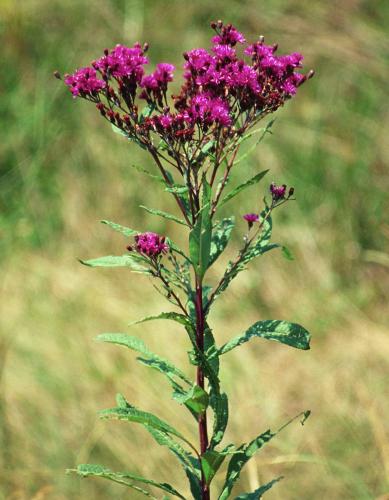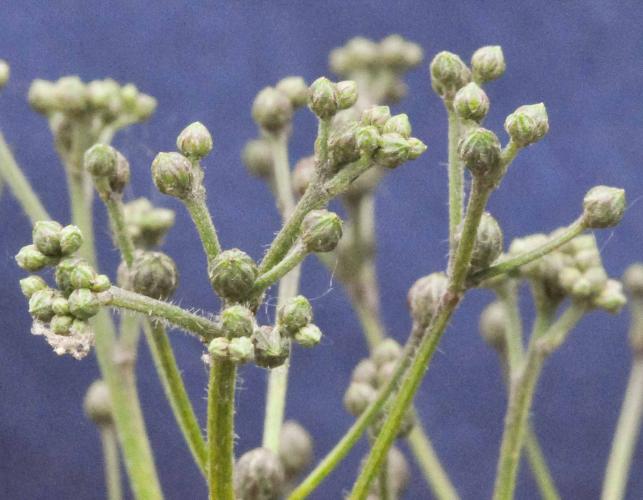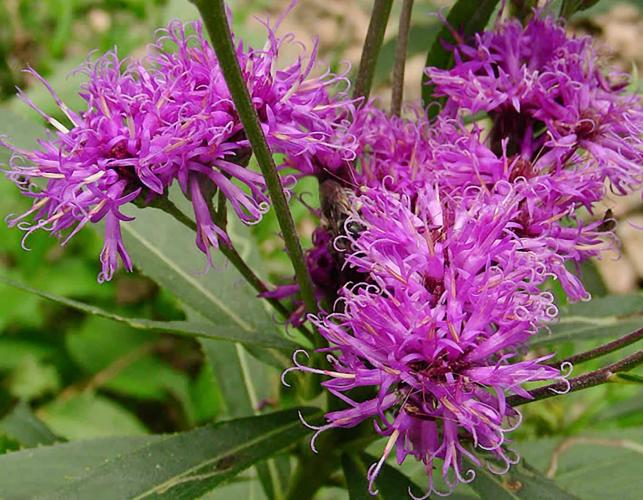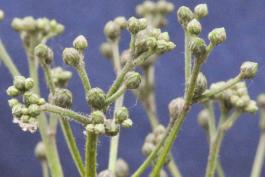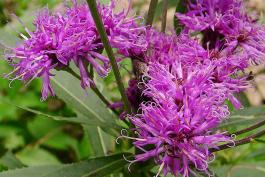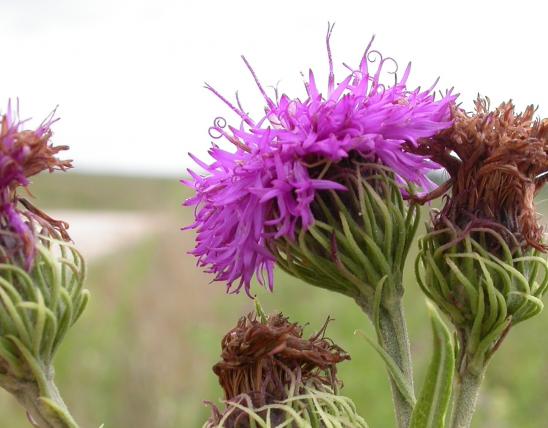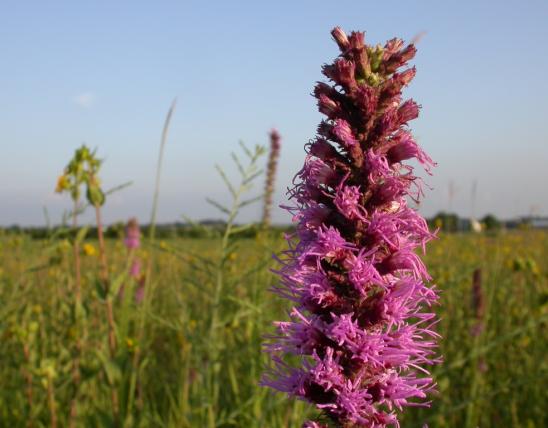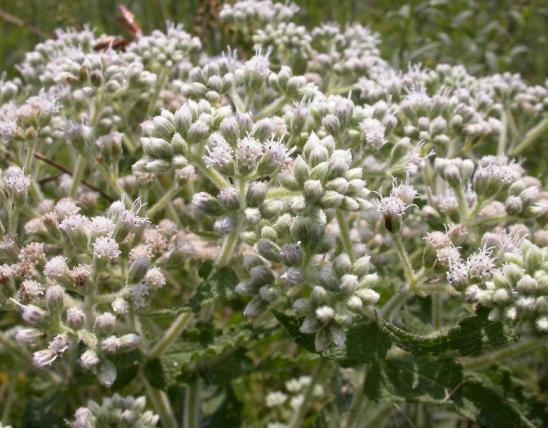
Starting in mid to late summer, ironweeds bear showy, rounded clusters of fuzzy-looking magenta or purple flowerheads at the branching tops of upright stalks. The foliage is often (but not always) grayish due to a covering of fine hairs on the leaves and stalks.
Five species of ironweeds (Vernonia spp.) occur in Missouri. As a group, Missouri’s ironweeds share these characteristics:
- They are perennial, upright, nonwoody plants, lack milky sap, and are not prickly or spiny. They branch multiple times near the top.
- The leaves are alternate, simple, unlobed, almost always toothed, with 1 main vein.
- The composite flowerheads are in irregularly branching clusters (often flat-topped) at the tops of the plant stalks. The involucral bracts (or phyllaries — the green, overlapping scaly or leaflike structures covering the base of the flowerheads) are important for identifying the different species; take note of their shape.
- The flowers are usually pink, magenta, or reddish purple. Rarely, they may be white.
- After flowering, the seeds are topped with bristles, giving the seed heads a fluffy appearance.
Here’s how to tell the difference between our five species of ironweeds:
Curlytop, Arkansas, or great ironweed (Vernonia arkansana)
The easiest to identify. Distinguished from the others by its thin, tapering, curling, threadlike involucral bracts. Also, it is usually a glabrous (smooth) or only sparsely hairy plant.
Scattered mostly in the Ozark and Ozark border regions; uncommon along the Missouri and Mississippi rivers. It is the characteristic species of stream banks and gravel bars in the Ozarks, but it can occur in many other habitats. Occurs on banks of streams, margins of sloughs, fens, openings in bottomland forests, moist upland forests, bottomland prairies, rarely glades; also pastures and roadsides.
Often hybridizes with western ironweed (V. baldwinii), especially where dry road and moist stream habitats intersect.
- Height: about 2–5 feet.
- Leaves: relatively narrow; usually sharply toothed but occasionally lack teeth; margins often somewhat turned under; glabrous (smooth, hairless) to sparsely hairy; dotted with tiny, impressed resin glands.
- Florets per head: 50–120 (the flowerheads are relatively wide).
- Involucral bracts: very distinctive, narrowly tapered, threadlike, and curly (except for the outermost/lowest bracts).
- Blooms: July–October.
Western, or Baldwin’s ironweed (Vernonia baldwinii)
By far the most abundant species of ironweed in Missouri. It is most similar to tall ironweed (V. gigantea) and Missouri ironweed (V. missurica). It is distinguished from them by its involucral bracts, which have pointed, angled or recurved (curled back) tips, resin glands, and keeled midveins. Also, compared to tall ironweed, western ironweed is stouter and has wider leaves.
Scattered to common nearly statewide; less common in parts of northern Missouri and the Bootheel. Very abundant, mostly living in drier, more upland habitats than our other ironweeds. Occurs on upland prairies, glades, blufftops, upland forests, less commonly stream banks and pond edges; also pastures, fencerows, fields, roadsides, and other open, disturbed areas.
Often hybridizes with our other species. Also, there are two subspecies in Missouri: baldwinii and interior.
- Height: about 2–5 feet.
- Leaves: The undersurface with more or less evenly distributed, relatively long, often bent or tangled hairs (hairs obscuring any glandular dots); margins usually finely toothed, less commonly coarsely toothed.
- Florets per head: 17–34. White-flowering forms occasionally occur.
- Involucral bracts are angled or more commonly short-tapered to a sharply pointed tip that is loosely ascending or curving/spreading back, usually with abundant minute, impressed resin glands on both sides of the noticeably keeled midvein.
- Blooms: May–September.
Prairie, smooth, or common ironweed (Vernonia fasciculata)
Mostly limited to northern and western Missouri. Usually a smooth or hairless plant, it is distinguished by its combination of smooth or hairless, gland-dotted leaf undersides and the characteristics of its involucral bracts.
Scattered in the northern half of Missouri, especially in the northwest; uncommon elsewhere. Occurs on bottomland prairies, marshes, fens, lake margins, stream and river banks; also fallow fields, roadsides, railroads. Look for it growing near prairie cordgrass.
Can hybridize with all our other ironweeds, though combinations with curlytop ironweed (V. arkansana) are rare, since they usually don’t grow near each other.
- Height: about 1½–4½ feet.
- Leaves: This species is distinguished from all (except for curlytop ironweed, V. arkansana) by the smooth (glabrous; hairless) undersurface of the leaves, which are dotted with tiny, impressed resin glands (these pits are easiest to see in dried leaves). Blades are relatively narrow. Margins are sharply toothed.
- Florets per head: 10–26.
- Involucral bracts are neither curly and threadlike, nor are they narrowly pointed and curling back; instead, they are rounded or broadly angled to a bluntly pointed tip, the innermost (top) ones sometimes with a minute, sharp point; appressed, glabrous (smooth); the midvein not keeled or only slightly keeled toward the tip. The margins are sometimes minutely hairy.
- Blooms: July–September.
Tall or giant ironweed (Vernonia gigantea; formerly V. altissima)
Can attain the largest size. Most similar to Missouri ironweed (V. missurica) (but note the numbers of florets, and stem and leaf hairiness), and western ironweed (V. baldwinii) (but note the involucral bract characters).
Scattered nearly statewide; primarily in the southeastern quarter of the state; apparently absent from many parts of northern and eastern Missouri. Occurs on banks of streams, rivers, spring branches, margins of ponds and lakes, bottomland forests, swamps, bottomland prairies, fens; also pastures, ditches, and roadsides.
- Height: usually about 2½–6½ feet, but sometimes up to 10 feet. Note that although it can be taller than all our other ironweeds, there is considerable overlap among them.
- Stems are minutely hairy, sometimes becoming nearly glabrous toward the base.
- Leaves: upper surface glabrous (smooth) or somewhat roughened; undersurface minutely hairy, especially along the veins, occasionally sparse longer hairs also present along the veins (hairs obscuring any glandular dots); margins sharply toothed.
- Florets per head: 13–30. White-flowering forms occasionally occur.
- Involucral bracts are neither curly and threadlike, nor are they narrowly pointed and curling back; instead, they are rounded or broadly angled to a bluntly pointed tip, the innermost (top) bracts rarely abruptly tapered to a minute, sharp point, appressed, glabrous (smooth) or sparsely and minutely hairy, the midvein not keeled or only slightly keeled toward the tip. The margins are occasionally minutely hairy.
- Blooms: August–October.
Missouri ironweed (Vernonia missurica)
Note the relatively large number of florets per flowerhead and usually hairy stems and leaf undersides. It was named missurica after the Missouri River.
Scattered in the eastern half of Missouri; uncommon farther west. Occurs on banks of streams, rivers, spring branches, bottomland forests, swamps, fens, margins of sinkhole ponds, bottomland to upland prairies; also pastures, ditches, old fields, fencerows, roadsides, and other open, disturbed areas.
- Height: about 2½–6½ feet.
- Stems: hairy, with longer, spreading or often bent to tangled hairs toward the tip, sometimes minutely hairy toward the base.
- Leaves: Upper surface minutely hairy or roughened, sometimes nearly smooth; undersurface with more or less evenly distributed, relatively long, often bent or tangled hairs (hairs obscuring any glandular dots); margins coarsely toothed to nearly toothless.
- Florets per head: 32–60. White-flowering forms have occurred in other states.
- Involucral bracts are neither curly and threadlike, nor are they narrowly pointed and curling back; instead, they are rounded or broadly angled to a bluntly pointed tip, the innermost (top) ones often abruptly tapered to a minute, sharp point, appressed, glabrous (smooth) or minutely hairy, glandless or with sparse, minute, impressed resin glands toward the tip, the midvein not keeled or only slightly keeled toward the tip. The margins are usually cobwebby-hairy.
- Blooms: July–September.
Ironweed hybrids? Our five species of ironweeds often interbreed and produce offspring that share traits of the parent species, making them tricky to identify. Even more confusing, these hybrid plants are usually fertile, creating more unusual combinations. If you find an ironweed whose traits don’t quite fit any single species description, you may have found a hybrid. Look around for its two parent species nearby.
Similar species:
- Blazing stars, or gayfeathers (Liatris spp.), have similar purplish flowerheads, but these are positioned along the top portion of an upright, unbranching stalk (not in rounded, branching clusters).
- Thistles (Cirsium spp.) also have fuzzy, purplish flowers, but their foliage is spiny.
- The various species of knapweeds and star thistles (Centaurea spp.), such as cornflower, usually have solitary (not clusters of) flowerheads whose outer ring of florets have the corollas (petals) enlarged, resembling ray flowers.
- Joe-Pye weeds (Eutrochium spp.) and thoroughworts (Eupatorium spp.), overall, look something like ironweeds. The flowers of thoroughworts are white, and the leaves are mostly opposite. The flowers of Joe-Pye weeds are pink or purplish, and their leaves are in whorls on the stem.
- Yellow ironweed (Verbesina alternifolia) is similar in name only. It might have gotten its name because its leaves are somewhat similar. Otherwise, no would could mistake its clusters of yellow flowerheads, which look like droopy, ragged sunflowers, with the fuzzy magenta flowerheads of true ironweeds.
Height: prairie ironweed (V. fasciculata) may flower at only 20 inches tall, but tall ironweed (V. gigantea) can reach nearly 10 feet.
Statewide. The different species have different distribution patterns within the state.
Habitat and Conservation
Ironweeds may be found in nearly any habitat in Missouri, with different species more common in different habitats. Most Missouri species prefer lowland, or moist habitats, though our most common species, western ironweed (V. baldwinii), typically occurs in drier, upland sites.
In the Midwest, ironweeds are a familiar sight in overgrazed pastures, apparently because the plants are unpalatable to cattle. Most species in this genus produce toxic chemical compounds, but the species that occur in Missouri have not yet been implicated directly in livestock or human poisoning.
Status
Native Missouri perennial wildflowers.
The taxonomy of genus Vernonia has been changing in recent years, as botanists use DNA and other data to refine their understanding of the group. Some botanists only count about 20 species in the genus, restricting it to plants in North and South America, while older classification systems include 350 or even 500 species in the genus globally.
Human Connections
The name “ironweed” has several possible origins. It may have come from the grayish, rather metallic look of some species, which is caused by the rather dense, pale hairiness of the foliage. Others say it’s called ironweed for its tough stalks and overall rugged nature. Another possibility is the rusty-red color of the fuzzy pappus bristles, which are conspicuous as the seed heads mature.
Ironweeds can be good choices for native wildflower gardening. They are highly attractive to butterflies, and they provide vibrant late-season color, especially when paired with bright yellow goldenrod, which blooms about the same time. If you want to take pictures of butterflies, park yourself next to a bunch of these blooming flowers.
Cattle avoid eating ironweed. On pastures, ironweeds are labeled “increasers,” since their numbers tend to increase over time when a pasture is heavily grazed. If you see a pasture covered with ironweed, it may have experienced heavy grazing. Most ironweeds produce toxic chemical compounds, making them distasteful to livestock, but the species that occur in Missouri have not yet been implicated directly in livestock or human poisoning.
Lactones extracted from an African species of Vernonia have been shown to inhibit tumor formation.
Native Americans used ironweeds medicinally, mainly as a pain reliever.
The genus name, Vernonia, honors William Vernon (1666–1711), an English botanist and entomologist who specialized in mosses and butterflies; he collected biological specimens in Maryland in 1698 but otherwise stuck to England. The German naturalist J.C.D. von Schreber named the genus to recognize Vernon’s contributions to biology.
Like the names of many wildflowers, “ironweed” is a compelling, poetic word. It implies a scrappy, persistent toughness but also denotes an undeniably beautiful native wildflower. A Pulitzer prize-winning novel and its spinoff movie bear the name, and so does a Missouri bluegrass band.
Ecosystem Connections
The large, flat-topped clusters of intense purple flowers attract a wide array of bees, beetles, flies, butterflies, skippers, and other insects. These may feed on pollen, nectar, or both.
At least two species of digger bees, Melissodes confusiformis incondita and the eastern ironweed long-horned bee (M. denticulatus), are specialized to collect pollen primarily, or perhaps only, from ironweed species.
Some species of moths use ironweeds as their caterpillar food plants, including these:
- the ironweed borer moth (Papaipema cerussata), a deep brown, white-splotched moth whose caterpillars bore into the stems
- the parthenice tiger moth (Grammia parthenice), whose adults have black forewings with crisscrossed yellow streaks and bright orange, black-spotted hindwings
- the red groundling (Perigea xanthioides), a handsome rusty-red, brown, and gold-mottled noctuid.
Many other kinds of insects eat the leaves or flowers or bore into the stems or roots, or suck the sap. These include midge, moth, and beetle larvae, aphids, stink bugs, grasshoppers, tree crickets, and katydids. Leaf miners are insects whose larvae tunnel around within the leaves, eating the fleshy green tissues between upper and lower surfaces, leaving squiggly pale lines visible on the outside.
Crab spiders, orbweavers, assassin bugs, robber flies, and other predatory arthropods hunt the many insects that visit the flowers or feed on the plants.
Though a colony of ironweeds can be the home of nearly an entire food chain’s worth of insects and other small animals, mammals typically don’t eat the bitter plants.

